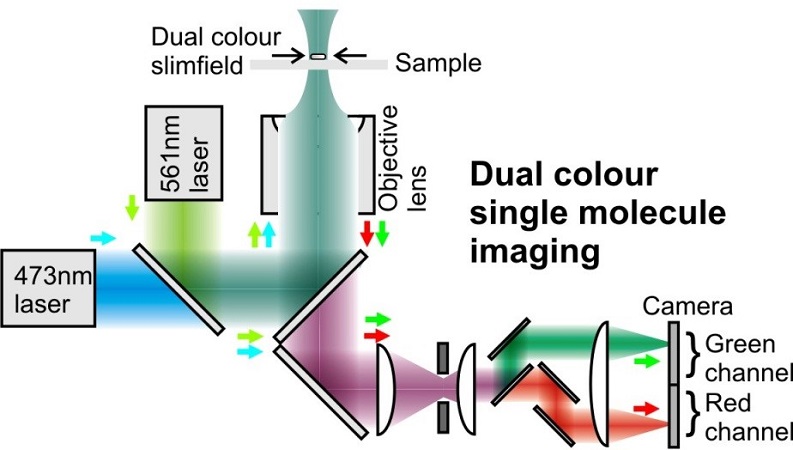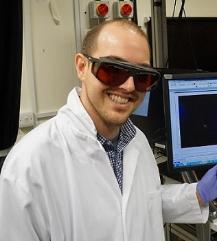
Single Molecular BioPhysics: Decapitating the beast of Averages
• Life is complex, and enormously heterogeneous
• Down to the level of single cells, and molecules within cells, we still see huge heterogeneity, even down to the bumpy nature of free energy molecular landscapes
• By using and developing ambitious new single-molecule biophysics tools we can probe the complexity of life, one molecule at a time
The Single-Molecule Biophysics team is headed by Professor Mark Leake, Anniversary Chair of Biological Physics and Coordinator of the Physics of Life Group.

Professor Leake is a physicist by training but now address challenging biophysical and biochemical questions in a range of biological processes. Following initial undergraduate studies as a ‘natsci’ in the University of Cambridge in 1990-93, he gained his PhD in the biophysics of muscle proteins using optical tweezers techniques in King’s College London, with subsequent postdoctoral positions in Oxford and Heidelberg. He later gained independence as a Royal Society University Research Fellow in Oxford, leading research themes in single-molecule cellular biophysics and molecular scale optical proteomics, prior to becoming the new Anniversary Chair of Biological Physics at the University of York in 2013. He was the Director Founder of the Biological Physical Sciences Institute and is now the Coordinator of the Physics of Life Group. General themes of his research involve (i) developing new biophysical instrumentation for addressing open biological questions, and (ii) applying these coupled to molecular biology and biochemical approaches to investigating questions concerning single molecules under physiologically relevant environments. He has developed an exceptional cluster of biophysical techniques enabling the imaging and manipulation of single molecules with extraordinary control.
magneto-optical tweezers super-resolution imaging tool
This scientific success is founded on the single-molecule fluorescence microscopy with molecular and cellular manipulation and precision microfluidics technology. His team is in an ideal position to take the leap from studying single molecules to investigating entire complex biological processes at much higher length scales of cells and tissues. For full details of his team’s research check out their full publications – highlights include adding insight into the behaviour of the flagellar motor of bacteria [1,2], DNA replication, repair and remodelling [3-6], protein transport, oxidative phosphorylation, signal transduction, transcription and gene regulation [7], antibiotic tolerance and liquid-liquid phase condensates [8] and photosynthesis in viral-like nanomachines [9]. These advances have been underpinned by innovative tools and techniques enabling robust quantification of molecular and cellular properties: the spatiotemporal dynamics of functional molecular machines, their architecture and mechanical properties, the nature of their functional interactions, and their level of expression on a live cell-by-cell basis. We also have exciting in vitro based projects emerging in DNA-protein interactions using a combination of AFM imaging, single-molecule FRET, tethered particle motion and an exciting new magneto-optical tweezers super-resolution imaging tool [10].
Key to the successes of the team are two truly inspirational early career academics, Dr Adam Wollman, a Fellow for the Centre of Future Health,and Dr Steven Quinn, a lecturer and research fellow in biophysics. Adam has core expertise in bespoke optical microscope construction and image analysis coding. His adventurous project for the Centre for Future Health involve working towards using cutting-edge DNA synthetic engineering approaches to develop novel biosensors for the detection of glucose levels in live cells.
Dr Adam Wollman
Dr Steve Quinn
Steve’s research involves using a range of single-molecule biophysics and biophysical chemistry tools to understand protein-protein interactions. These include interactions with lipid bilayers, both in controlled lipid vesicles and in live cells, how they cluster and, in some cases form pores. He has particular interests in understanding the protein nucleation process that lead to death of nerve cells and ultimately dementia, in particular Alzheimer’s disease.
Key Publications
1. Nature 437:916 (2005) 2. Nature 443:355 (2006) 3. Science 328:498 (2010) 4. Science 338:528 (2012) 5. Nucleic Acids Research 10:210 (2019) 6. Nucleic Acids Research, Syeda & Wollman et al 47:6287 (2019) 7. eLife 6:e27451 (2017) 8. Mol Cell 73:143 (2019) 9. Plant Cell, Sun & Wollman et al, 31:1648 (2019) 10. Photonics 2:758 (2015)


